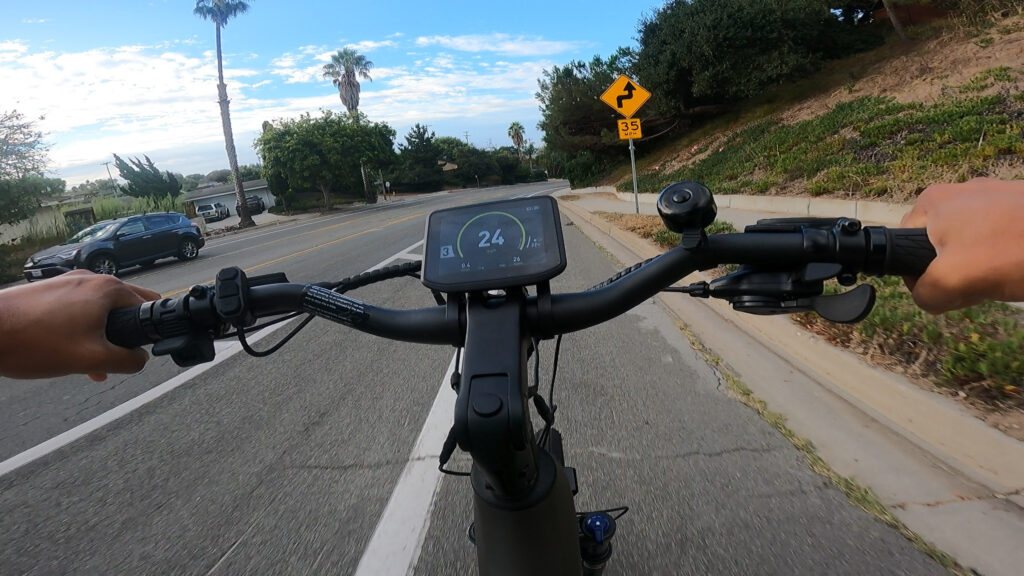
A critical yet overlooked component of bicycles is the stem, which connects your handlebars to the fork. Changing your bike stem’s height can get you into a more comfortable or aerodynamic position. An adjustable bike stem is especially handy for ebike riders, who might face different terrain and wind on the same day and need to change their riding position on the go.
There are many options for extending bike handlebars, and some feature different levels of adjustability. We’ve had the chance to try out several adjustable bike stems and will share our experiences with them in this article. Using the right bike stem can take your riding to a higher level, and reading our thoughts will guide you to make the best choice.
HOW TO RAISE BIKE HANDLEBARS
Proper handlebar placement affects your riding posture. Low handlebars can lead to discomfort. While it may not be as critical as changing a flat tire or adjusting brakes, extending bike handlebars yourself can occasionally save you a trip to the bike shop. Fortunately, adjusting their height is simple after a proper lesson.
First, you must determine whether you have a threadless or threaded handlebar stem:
How To Tell You Have A Threadless Stem
Check for two bolts at the top and back corner of your handlebars. On threadless handlebars, these bolts clamp the horizontal stem to the vertical steerer tube that extends from the headset.
How To Tell You Have A Threaded Stem
The stem on threaded handlebars is a single piece of metal, extending up from the headset and elbowing out to where it clamps the handlebar over your front wheel.
In other words, a threaded stem connects to the fork inside the headset, while on a threadless stem, you can see where it clamps onto the fork steerer tube above the headset.
Raising Threadless Handlebars
- Find the right size Allen wrench or hex key that matches the bolts on the back of your handlebar stem. The typical sizes are 4mm, 5mm, or 6mm.
- Loosen the bolts at the back of the handlebar stem. Once loose, your handlebars should move sideways without moving the wheel.
- Unscrew and detach the handlebar stem’s bolt and top cap with your hex key. After removing the cap, slide the handlebars off the top of the steerer tube.
- Add spacers on top of the steerer tube. Take the spacers that were above the handlebar stem and place them below, creating more room between the headset and the handlebars (If there are no spacers above the stem and your steerer tube is too short to accommodate additional ones, you may need a threadless bike stem riser instead to add height).
- Put your handlebars back onto the steerer tube, aligning them with the wheel’s center. A proper alignment is essential for a smooth riding experience.
- If there are any spacers left, place them above the handlebars.
- Alternate tightening the two clamp bolts little by little instead of tightening one all the way, and then the other. Tighten each bolt in small increments until the wrench leaves imprints on your hands and the handlebars can’t move up and down, or side to side.
Raising Threaded Handlebars
- Use a tape measure to determine the length from the top of the handlebars to the headset. Write down this measurement.
- Use an Allen wrench to loosen the bolt at the top of the handlebar stem. With one hand, grip the handlebars while using the other hand to turn the top bolt counterclockwise 4-5 times until the handlebars move up and down without resistance.
- Lift your handlebars to the correct height and tighten the top bolt just enough so it won’t fall. The bottom of the stem tube should have a marking telling you not to exceed that height, don’t raise the handlebars above that point.
- Verify your handlebars are straight with the front wheel.
- Once the handlebars are aligned and at the desired height, tighten the top bolt completely.
Here are our top picks for the best bicycle stem risers:
FOMTOR Bicycle Handlebar Stem – ($18.99)
The FOMTOR Bike Stem is a quality replacement component. This stem is lightweight and durable and made from high-strength CNC machined 6061 T6 aluminum alloy. I was impressed with the stem’s perfect fit to the handlebar and the frame, making for a solid feeling. The handlebars felt just as strong as with the original stem, and my hands were in a more comfortable position.
It was easy to install the FOMTOR Bike Stem on the original front fork stem, you simply tighten it on in place of the old stem. The four-bolt bar clamp provides a secure connection, while the stem’s 35° angle raises your handlebar’s height, giving you a more comfortable ride. However, this stem only fits 31.8mm handlebars and 28.6mm front fork stem diameters, so be sure to check your bike’s measurements before purchasing. Overall, the FOMTOR Bike Stem is a perfect solution to improve your bike’s ride quality and comfort.
Qikour Adjustable Road Bike Handlebar Riser Stem – ($19.99)
This stem enables riders to quickly adjust their handlebar angle with a hex wrench. It features degree marks from 0-60 to make finding the correct angle simple. Also, installation is straightforward, and it fits the tube and handlebar sizes its specifications say it will. The high-quality aluminum alloy caught my attention with its durability and low weight. However, riders should regularly check this stem’s bolts, as they may loosen over time, causing the handlebars to slip.
REDSHIFT ShockStop Suspension Stem – ($189.99)
The Redshift bike stem delivers a more comfortable ride with less hand fatigue. Its high-quality titanium construction is sturdy and lightweight, making it a long-lasting addition to your bike. The suspension system absorbs 70% of shocks with 20mm of travel, making your handlebars buzz-free.
The stem comes in five lengths, and its clamps fit standard steerer tube and handlebar sizes for easy installation. Most sizes feature a flip that can adjust +/- 6°, while the 100mm length stem offers a 30° angle for a more upright riding position. A unique feature of this stem is you can tune the suspension stiffness by adding 1-5 elastomers between its arms. However, some may find it pricey, and the packaging is underwhelming.
TRIWONDER Adjustable Road Bike Stem – ($18.99)
The TRIWONDER Stem angle is adjustable from 0-60°, making it perfect for riders who want to customize their sitting position. It’s a hollow, lightweight bike stem suitable for most bikes with threadless handlebar stems. To install it, remove your old stem and put this one in its place on the steerer tube. The 4-bolt bar clamp holds the handlebar securely. Be aware, it doesn’t come with installation instructions.
Azarxis Short Handlebar Road Bike Stem – ($10.99)
The high-strength aluminum alloy Azarxis road bike stem is an excellent option for those seeking more comfort without added weight. It also helps reduce hand numbness by allowing a more upright position. Additionally, the consistent, unmarked black finish gives it a high-quality appearance. Installation is also easy, requiring only a connection to the original front fork stem.
This bike stem’s four-bolt clamp holds your handlebar securely in place. However, it may require additional spacers to fit with some handlebar or steerer tube sizes. Overall, the Azarxis road bike stem offers excellent construction quality, easy installation, and versatility. Also, it’s the lowest price option on this list.
Ritchey Adjustable Aluminum Alloy Bike Stem – ($54.95)
This adjustable bike stem provides riders a secure and comfortable experience on or off-road. The stainless steel bar and steerer tube clamp bolts deliver superior durability. It adjusts +/-55°, allowing riders to find the most comfortable stem angle, but the high-quality design won’t wiggle or creak as other options might. The installation process is easy, but be careful not to overtighten the adjusting screw. Also, there are no angle markings to guide your angle alignment, which may be an issue for some.
FOMTOR 31.8 Stem 60mm 7 Degree Light-Weight Bike Handlebar Stem – ($18.99)
The FOMTOR 31.8 Stem 60mm 7 Degree Bike Handlebar Stem is a versatile bike stem suitable for various bicycle types, and its light and durable construction makes it an excellent choice. Made of high-strength CNC machined 6061 T6 aluminum alloy, this bike stem has an angle of +/- 7°, a handlebar clamp diameter of 31.8mm, and a steerer tube clamp diameter of 28.6mm. The installation process is easy, and the four-bolt bar clamp secures the handlebar in place.
Satori UP2+ – E Bike – Bicycle Riser Extension Adjustable Handlebar Stem – ($39.98)
The Satori UP2+ is for ebikes with a top speed of 28 mph(45 km/h). Its heavy-duty, two-bolt design ensures rigidity and efficient handling, while its adjustable range allows comfortable upright or race-riding positions. The internal cable routing allows you to run two cables through the stem. It’s compatible only with a 1-1/8″ (28.6mm) fork steerer tube and a handlebar bar bore of 31.8mm. This bike stem riser’s 3D forged alloy creates a hollow, durable unit weighing only 414g. Finally, the bike stem riser is easy to install and includes a 5-year warranty.
Conclusion
Buying the right bicycle stem riser can help you ride further and faster while feeling better on and off the saddle. There are several factors to consider when choosing the best one, including rise needed, adjustability, weight, and durability.
After researching and reviewing several options, we’ve found that the Ritchey Adjustable Aluminum Alloy Bike Stem is currently the best product available. Ritchey is a well-known brand and the high-quality design will last as long as your frame. Overall, the Ritchey Adjustable Aluminum Alloy Bike Stem delivers everything you need to upgrade your riding experience.

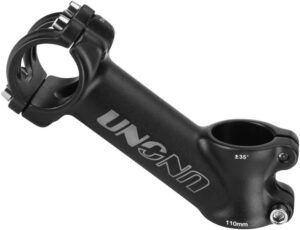
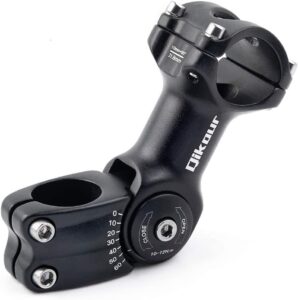

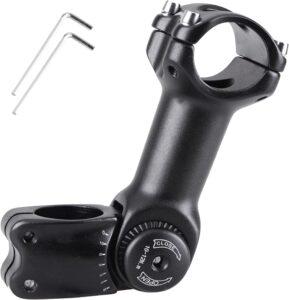

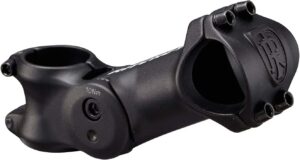
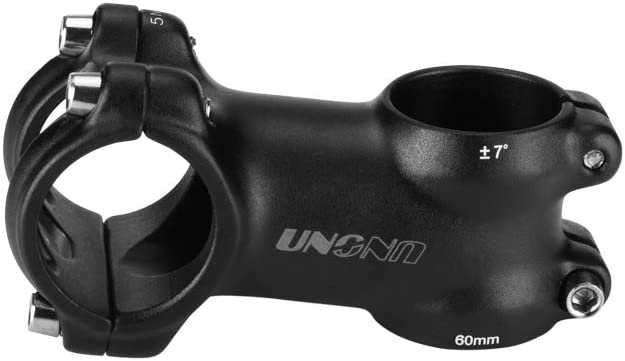
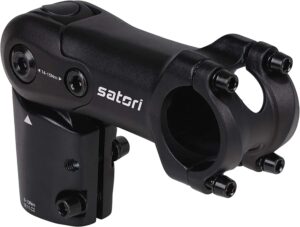
Thank you for this article. Are all of the stem risers for threadless stems? And is there any way to get more height on a threaded stem that’s already raised to its maximum height?